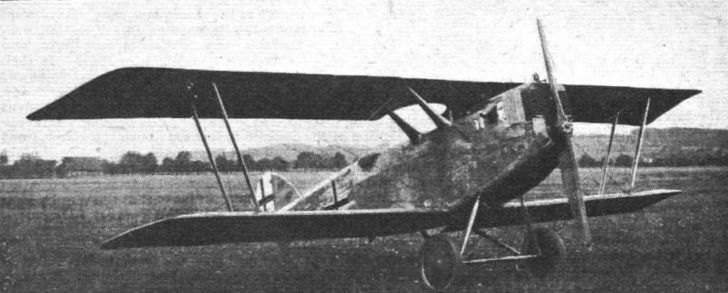
Flight, December 1920
The Do.C. I, 1917
During the year 1917 a break occurred in the series of monoplane flying boats designed by Herr Dornier. By way, it is believed, of gaining some experience with metal fuselage covering to act at the same time as fuselage bracing, a land machine, known as the Do.C.I, was designed and constructed. This was a single-engined tractor biplane with a 160 h.p. Mercedes engine. As the accompanying photograph will show, the Do.C.I was a very clean-looking job, and from a constructional point of view was chiefly remarkable as being the first instance of plain, smooth metal body covering acting at the same time as fuselage bracing. The wings were of ordinary construction, except for the metal spars shown in our diagram. As distinct from the majority of German machines it had a nose radiator, and altogether it looks much more like an English than a German aeroplane. The top plane centre section is carried, not on a cabane as is usual German practice, but on outwardly raked struts of sheet metal, designed to give sufficient rigidity without wire bracing, thus leaving the space between the centre section and the top of the fuselage free of obstructions. One might wonder why such a machine was not turned out in quantities, as it certainly appears to be far ahead of any contemporaneous German aeroplane familiar at the front at that time. The explanation is that the metal construction was so heavy as to reduce the performance, which failed, we understand, to come up to the required standard of climb. A small general arrangement drawing of the Do.C.I, or Zep.C.L.I as it is sometimes called, is published herewith. Also the climb recorded on a test flight on March 18, 1918. It will be seen that an altitude of just under 5,000 metres (16,500 ft.) was reached in one hour. The time allowed for this class of machine is 45 minutes, so that the Zep.C.L.I fell short of the requirements by 15 minutes. Up to an altitude of 4,000 metres it was almost up to requirements, but the last 1,000 metres, instead of occupying 16 minutes, took half-an-hour.
We have devoted a considerable amount of space to this machine, since it was probably the first to be built with no form of fuselage bracing beyond that afforded by the plain sheet metal covering. Although the machine failed by a relatively small margin to come up to the German Government specification for performance, there can be little doubt that it taught Herr Dornier many a valuable lesson of which he later made use in designing other all-metal machines.
- Flight, December 1920
The Do.C. I, 1917
Фотографии
-
Flight 1920-12 / Flight
The Do.C.I: This machine was the first to employ smooth metal covering of the fuselage without internal bracing.
-
Aeroplane Monthly 1990-10 / M.Oakey - Grapevine
Before the fire ... the storage hangar, neatly packed with reserve airframes. Visible here are (from left) the Dornier-Zeppelin (Zeppelin-Lindau) C IV and the fuselage of the variable-incidence Paul Schmitt biplane, both of World War One vintage, and Tiger Moth K2570.
Другие самолёты на фотографии: De Havilland Tiger Moth / D.H.82 - Великобритания - 1931Schmitt Type 6 / 7.B2 - Франция - 1914
-
Flight 1920-12 / Flight
THE DO.C.I: Sections, etc., of the metal spars.
- Фотографии



